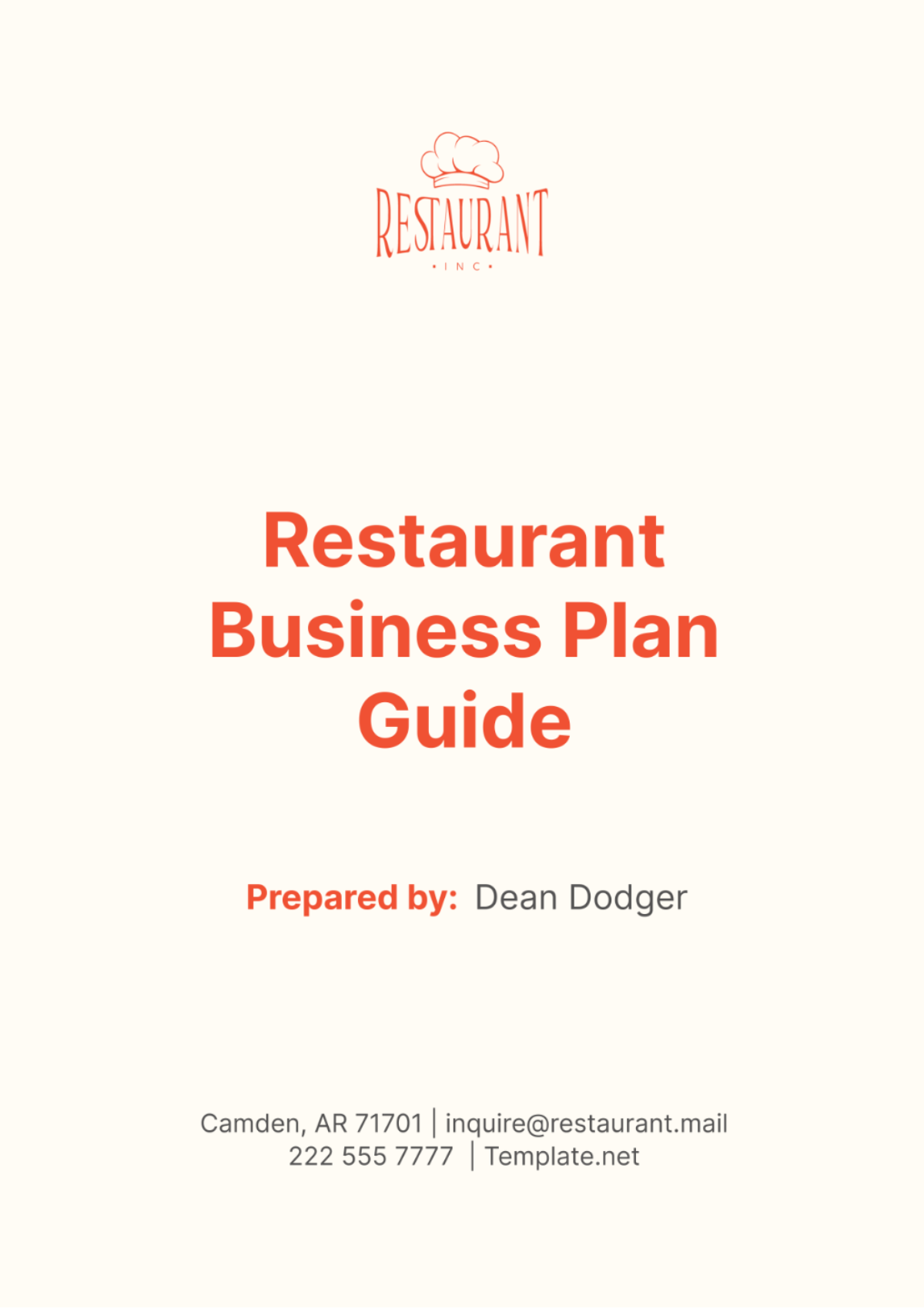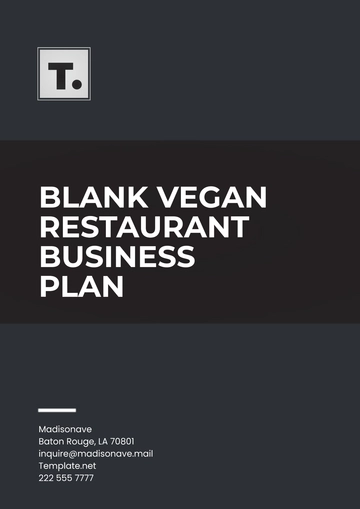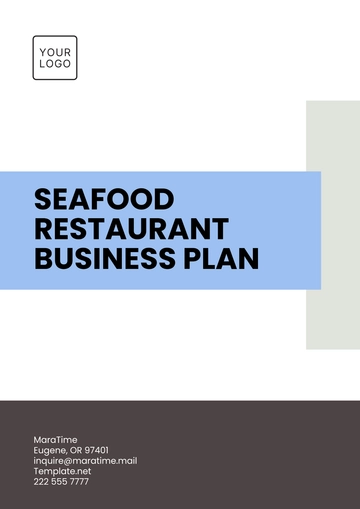Free Restaurant Business Plan Guide

I. Executive Summary
A. Concept Overview
Name: [Your Company Name]
Type: Casual dining
Cuisine: Farm-to-table, organic, vegetarian
Location: [Your Company Address]
Unique Selling Points: Locally sourced ingredients, eco-friendly environment, seasonal menu
[Your Company Name] will offer a vibrant dining experience focused on fresh, organic, and locally sourced vegetarian cuisine. Our unique selling point is our commitment to sustainability, both in the food we serve and our environmentally friendly operations. The downtown Springfield location will attract health-conscious diners and professionals looking for nutritious and delicious meal options.
B. Mission Statement
At [Your Company Name], our mission is to provide a unique dining experience that celebrates the freshness and flavor of locally sourced, organic ingredients while promoting sustainability and a healthy lifestyle.
We aim to create a welcoming space where the community can enjoy high-quality vegetarian meals that are both nourishing and environmentally friendly. Our dedication to sustainability extends beyond our menu to include eco-friendly practices in all aspects of our operations.
C. Business Objectives
Achieve monthly revenue of $[00,000] within the first year.
Maintain a customer satisfaction rating of 90% or higher.
Reach break-even within the first 12 months of operation.
Open a second location within three years.
Our primary objectives include achieving financial stability and ensuring customer satisfaction through exceptional service and high-quality food. We plan to expand our brand by opening a second location once we establish a strong customer base and consistent profitability at our first location.
II. Business Description
A. Company Overview
Ownership: Sole proprietorship owned by Jane Doe
Legal Structure: Limited Liability Company (LLC)
Location: [Your Company Address]
[Your Company Name] is owned and operated by Jane Doe, a seasoned restaurateur with over 15 years of experience in the industry. The business is structured as an LLC to protect personal assets and provide a clear legal framework for operations. Located in the heart of downtown Springfield, the restaurant is positioned to attract a diverse customer base.
B. Restaurant Concept
[Your Company Name] offers a cozy, inviting atmosphere with a focus on sustainability. The decor features recycled materials, and the menu changes seasonally to highlight the best local produce. The target audience includes health-conscious diners, vegetarians, and eco-friendly consumers.
Our restaurant concept revolves around creating an environment that not only serves delicious, healthy food but also educates and inspires the community about sustainable living. The ambiance will be warm and earthy, with natural light and green plants enhancing the dining experience.
III. Market Analysis
A. Industry Analysis
The farm-to-table movement has grown significantly in recent years, with increasing consumer demand for organic and locally sourced food. The casual dining sector is also experiencing growth, driven by a trend towards healthier eating options.
The restaurant industry is shifting towards sustainability, with a 15% annual growth in the farm-to-table segment. Consumers are more informed and selective about their food choices, prioritizing health and environmental impact. This trend provides a strong foundation for [Your Company Name]'s business model.
B. Target Market
Demographics: Ages 25-45, middle to upper-middle class, urban dwellers
Psychographics: Health-conscious, environmentally aware, prefers organic and locally sourced products
Behavioral: Regular diners, willing to pay a premium for quality and sustainability
Our target market consists of urban professionals and families who prioritize health and sustainability in their lifestyle choices. They are typically well-educated, have disposable income, and are willing to spend more on food that aligns with their values. We aim to attract this demographic through our commitment to quality and environmental responsibility.
C. Competitive Analysis
Direct Competitors:
Farm Fresh Café: Known for organic offerings but lacks a vegetarian focus.
Urban Green: Popular but more expensive and located outside downtown.
Indirect Competitors:
Fast-casual salad bars: Offer quick, healthy meals but without the full dining experience.
Our main competitors include local organic and health-focused restaurants. Farm Fresh Café offers organic options but does not cater specifically to vegetarians, while Urban Green has a similar concept but is priced higher and is less conveniently located. Fast-casual salad bars provide competition in terms of healthy options but lack the ambiance and full dining experience we offer.
IV. Marketing Strategy
A. Branding
[Your Company Name]'s brand will emphasize sustainability, freshness, and health. The logo will feature green hues and natural imagery, and all marketing materials will highlight our commitment to local sourcing and eco-friendly practices.
Our branding strategy focuses on creating a strong visual identity that resonates with our target market. We will use earthy colors and natural elements in our design to convey our commitment to sustainability. Consistent branding across all platforms will help build brand recognition and loyalty.
B. Marketing Plan
Social Media: Active presence on Instagram, Facebook, and Twitter showcasing our dishes, local suppliers, and eco-friendly practices.
Website: A user-friendly website with an online reservation system, menu details, and blog posts about our farm-to-table journey.
Local Partnerships: Collaborate with local farmers' markets and health clubs for cross-promotions.
Launch Event: Host a grand opening with free tastings, live music, and local media coverage.
Our marketing plan involves leveraging social media to create buzz and engage with our audience. The website will serve as a central hub for information and reservations, while local partnerships and a well-publicized launch event will help us build a strong initial customer base.
C. Sales Strategy
Loyalty Program: Implement a rewards program to encourage repeat visits.
Happy Hour: Offer discounts on select items during off-peak hours.
Seasonal Promotions: Introduce limited-time menu items to create buzz and drive sales.
We will implement a loyalty program to foster customer retention and incentivize repeat visits. Happy hour specials and seasonal promotions will help attract customers during slower periods and keep the menu exciting and dynamic.
V. Menu Development
A. Menu Design
The menu will be designed to highlight seasonal produce, with sections for appetizers, entrees, desserts, and beverages. A separate menu for vegan and gluten-free options will be available.
Our menu design focuses on showcasing the freshest seasonal ingredients, with clear indications of vegan and gluten-free options to accommodate dietary preferences. The menu layout will be visually appealing and easy to navigate, enhancing the overall dining experience.
B. Recipe Costing
Each menu item will be costed to ensure profitability. For example:
Menu Item | Ingredient Cost | Price |
|---|---|---|
Kale Salad | $[00] | $[00] |
Roasted Vegetable Plate | $[00] | $[00] |
Accurate recipe costing ensures that each dish is priced appropriately to cover costs and achieve a healthy profit margin. By regularly reviewing and updating our cost analysis, we can maintain profitability and adjust prices as needed.
C. Sourcing Ingredients
We will source ingredients from local farms within a 50-mile radius. Key suppliers include:
Springfield Organic Farms for vegetables
Local Dairy Co-op for cheese and dairy products
Building strong relationships with local suppliers ensures a steady supply of fresh, high-quality ingredients. By sourcing locally, we support the community and reduce our carbon footprint, aligning with our sustainability goals.
VI. Operations Plan
A. Location and Layout
The restaurant will be located at [Your Company Address], featuring a 1,500 square foot dining area with seating for 60 guests. The layout will include an open kitchen, a small bar area, and a patio for outdoor seating.
The location is strategically chosen for its high foot traffic and proximity to local businesses and residential areas. The interior design will incorporate natural elements like reclaimed wood and live plants to create a warm, inviting atmosphere. The open kitchen allows customers to see their meals being prepared, emphasizing transparency and quality.
B. Staffing Plan
Roles and Responsibilities:
General Manager: Oversee daily operations, manage staff, and ensure customer satisfaction.
Head Chef: Design menus, supervise kitchen staff, and maintain quality control.
Service Staff: Waitstaff, bartenders, and hosts to provide exceptional customer service.
Support Staff: Dishwashers, janitorial staff, and prep cooks.
Hiring Plan:
Initial hiring of 20 staff members with a focus on experience and alignment with our values.
Ongoing training programs to maintain service standards.
C. Service Standards
Customer Service: Friendly, attentive service with a focus on creating a welcoming atmosphere.
Quality Control: Regular checks to ensure consistency in food quality and presentation.
Feedback: Implement a system for collecting and responding to customer feedback.
We will conduct regular training sessions for staff to maintain high standards of service and ensure all team members understand our commitment to customer satisfaction. Quality control procedures will include daily kitchen inspections and customer feedback reviews to continuously improve our offerings.
D. Technology and Equipment
Point-of-Sale System: Modern POS system for efficient order processing and inventory management.
Kitchen Equipment: High-quality stoves, ovens, and refrigeration units to ensure food safety and efficiency.
Software: Restaurant management software for scheduling, reservations, and payroll.
Investing in the latest technology and equipment will streamline our operations, reduce errors, and enhance the customer experience. The POS system will integrate with our inventory management software to keep track of stock levels and reduce waste.
VII. Financial Plan
A. Startup Costs
Item | Cost |
|---|---|
Renovations | $[00,000] |
Equipment | $[00,000] |
Initial Inventory | $[00,000] |
Licenses and Permits | $[00,000] |
Marketing and Advertising | $[00,000] |
Working Capital | $[00,000] |
Total Startup Costs | $[000,000] |
These startup costs cover the essential expenses required to launch [Your Company Name], ensuring we are well-equipped and ready to meet initial operational demands. This budget includes a buffer for unexpected costs to avoid financial strain.
B. Operating Budget
Expense | Monthly Cost |
|---|---|
Rent | $[00,000] |
Utilities | $[00,000] |
Salaries and Wages | $[00,000] |
Food and Beverage Costs | $[00,000] |
Miscellaneous Expenses | $[00,000] |
Total Monthly Expenses | $[00,000] |
The operating budget is designed to cover all monthly expenses, ensuring smooth day-to-day operations. By monitoring these costs closely, we can adjust our strategies to maintain profitability.
C. Cash Flow Statement
A detailed projection of monthly cash inflows and outflows, highlighting the importance of maintaining positive cash flow for sustainability.
Maintaining a positive cash flow is critical for covering ongoing expenses and planning for future growth. This statement helps us ensure liquidity and make informed financial decisions.
D. Profit and Loss Statement
Year 1 Projection:
Item | Amount |
|---|---|
Revenue | $[000,000] |
Cost of Goods Sold | $[000,000] |
Gross Profit | $[000,000] |
Operating Expenses | $[000,000] |
Net Profit | $0 (Break-even) |
This projection shows our expected financial performance for the first year, with the goal of breaking even by managing costs effectively and driving revenue growth.
E. Break-even Analysis
Understanding our break-even point helps us set realistic sales targets and pricing strategies to cover all costs and achieve profitability.
Item | Amount |
|---|---|
Fixed Costs | $[00,000]/month |
Variable Costs | $[0]/meal |
Average Price per Meal | $[00] |
Break-even Point | 833 covers/month |
VIII. Legal and Administrative Considerations
A. Licenses and Permits
Business License: Required for operating in Springfield.
Food Service Permit: Issued by the local health department.
Liquor License: Necessary for serving alcoholic beverages.
We will ensure compliance with all necessary legal requirements by obtaining the appropriate licenses and permits before opening. This process involves regular communication with local authorities and staying updated on any regulatory changes.
B. Health and Safety Regulations
Compliance with all local, state, and federal health regulations, including regular inspections and staff training on food safety practices.
We will implement strict health and safety protocols to ensure the well-being of our customers and staff. Regular inspections and training will help us maintain high standards of cleanliness and food safety.
C. Insurance
General Liability Insurance: To cover accidents and injuries.
Property Insurance: To protect against damage or loss of property.
Workers' Compensation Insurance: For employee protection.
Adequate insurance coverage is essential to protect our business from potential risks. We will work with a reputable insurance provider to secure comprehensive policies that cover all aspects of our operations.
- 100% Customizable, free editor
- Access 1 Million+ Templates, photo’s & graphics
- Download or share as a template
- Click and replace photos, graphics, text, backgrounds
- Resize, crop, AI write & more
- Access advanced editor
Manage your restaurant business effortlessly with Template.net's Restaurant Business Plan Guide Template. This fully editable and customizable template allows you to tailor every detail to your specific needs. Enhance your planning process using the AI Editor Tool for seamless, professional results. Perfect for aspiring restaurateurs and seasoned business owners alike!
You may also like
- One Page Business Plan
- Coffee Shop Business Plan
- Restaurant Business Plan
- Food Business Plan
- Real Estate Business Plan
- Executive Summary Business Plan
- Cover Page Business Plan
- Nonprofit Business Plan
- Daycare Business Plan
- Construction Business Plan
- Startup Business Plan
- Medical Business Plan
- Bakery Business Plan
- Service Plan
- Hotel Business Plan
- Catering Business Plan
- School Business Plan
- Healthcare Business Plan
- Transportation Plan
- Sports Plan
- Car Wash Business Plan
- Salon Business Plan
- Clothing Business Plan
- Farming Business Plan
- Boutique Plan

















